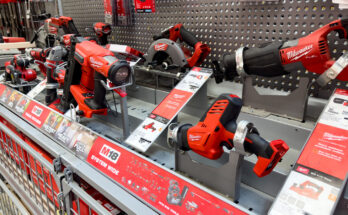Types Of Toilet Flappers And How To Identify Which On You Have
We may receive a commission on purchases made from links.
If you’ve ever spent some time thinking about your toilet, or if you’ve been forced to do so because of some unfortunate plumbing issues, you’ve likely realized that it’s made of a multitude of small, intricate, and confusing parts. Understanding how toilet parts work is hard but necessary for maintenance. One small part that you should know about is the toilet flapper — or, sometimes, flappers. Just like there are several major toilet flush systems and toilet designs on the market, there are several types of toilet flappers to match.
Without a toilet flapper, you wouldn’t have a flush. Toilet flappers open and close a valve between the toilet tank and toilet bowl, letting water flow from one to the other, creating that flush effect. Needless to say, flappers are crucial to having a working toilet. Knowing which type you have will help you recognize common toilet flapper problems and aid you if you ever need to replace one.
The different types of flappers go from what’s considered standard and universal to more complex mechanisms. Some are dual systems, others are balls, and some are even adjustable. What they all have in common is that they’re attached to the flush handle. When you reach for the handle, all you’re doing is essentially pulling the flapper upwards to open up the valve and let water through. Once the flapper closes the valve back up, the flush stops, and water starts to refill the tank.
The Universal Flapper
Let’s start with the basics. While there are many types of toilet flappers, there is one kind that’s considered standard and universal. These universal toilet flappers are easy to use with a variety of toilet designs, which also makes them a common and convenient choice for homeowners. Universal flappers are made of rubber and hinged, with a large rubber disk to cover the valve, and a chain attached to the handle. A ball inside the disk helps the flapper float and stay open until the tank is fully empty.
If you’re really not sure which type of flapper to use, a universal flapper is a fine choice that’s most likely to do the job. It’s also a good choice if you have really unique or old toilet that no other flapper can fit. However, the universal flapper is a bit of a jack of all trades. It’s usually a fine fit, but not a perfect fit. Therefore, it could potentially leak or break, but you can get a rubber universal flapper from Korky for around $6, so you’re not losing too much money if it doesn’t last. Universal flappers are a safe, affordable, and dependable option.
Adjustable Flappers
Adjustable toilet flappers are similar in shape to universal ones. What’s adjustable is not the actual shape of the flapper itself, but rather how much water it dispenses with each flush. To know whether you have a universal or adjustable flapper, look at the flapper itself. Adjustable ones have inscriptions on them indicating a minimum and maximum water setting. In between, there are numbers ranging from one to nine.
If you choose a setting of one, your water will dispense less water with each flush. As you move on to higher settings, more water is dispensed. Without going into the technical details, the way this works is by twisting and moving the location of a hole in the flapper that determines how quickly the flapper closes.
This is a good choice to reduce water usage by making the default flush much shorter. But, worry not, that doesn’t mean you need to reach into your toilet tank every time you need a heavier flush. You can just hold the handle down longer instead of just pressing once to keep the flapper open, so that more water passes through.
Dual-Flush Flappers
On the topic of lighter versus heavier flushes, you’ve probably noticed that some toilets have two buttons. One is for a small flush, the other for a heavier one. Some of these toilets have what’s called a dual-flush flapper. These work with two flush valves inside of the tank, each with its own flapper. You’ll know you have one of these because, well, you’ll have two flappers. One is typically red and the other is black, and they look similar to universal flappers with a hinged design and a flat, circular shape.
The other major difference between a dual-flush flapper and other kinds of flappers is the mechanism that attaches to the handle. Instead of a simple chain going from flapper to handle, like with the universal or adjustable flapper, the dual-flush flapper has two chains that connect to a plastic part in the middle. Whenever you’re flushing, it lifts either one flapper or both to dispense the right amount of water.
An American Standard dual toilet flapper costs around $38, but if you’re looking to replace a model with a worn-out seal, you don’t have to buy an entirely new flapper. You can just swap out the silicon seal section. These replacement toilet tank silicone flapper seals from Alocs cost only around $8.99 for two, making it an affordable fix.
Canister Flappers
Some toilets are designed for what’s called a flush canister flapper. This type of flapper tends to be preferred today because it’s efficient while using less water than some alternatives. Canister flappers let a lot of water through the flush valve in a short amount of time. Because the water comes rushing through at high speed, it has more power and works more efficiently to clear the bowl.
If you open your toilet tank to find a large vertical canister that moves up and down when pressing the handle, you’re likely dealing with a canister flush. The canister is attached to the flush handle with a chain, which pulls it upwards to let water through the valve.
It’s important to note that when you have a toilet tank with a canister, the flappers are not interchangeable. You can’t use a universal flapper instead of a canister one, for example. The good thing is that canister flappers don’t need to be changed often because they’re made of plastic. However, you do need to monitor and change the rubber seal at the bottom of the canister when it wears out. These pieces can be bought in a pack of three flush valve seals from Essential Values for only $8.89.
Tank Balls and Seat Disks
There are other types of flappers that we did not discuss, including older models like the tank ball or seat disk. Tank balls, for example, are types of flappers that you’ll mostly find on toilets from the 1950s or earlier, as they’ve been abandoned since. There, the mechanism to close the valve is a rubber ball attached to a metal rod. It works by sealing the valve with the ball, so while it’s commonly called a flapper, it doesn’t really “flap”. Still, it does the same job as a regular toilet flapper. Seat disks, on the other hand, are the ancestor of the flapper and work similarly, but they’re not quite as good at creating a tight seal.
You’re only likely to encounter these types of flappers on vintage toilets. If you’re renovating a mid-century home, for example, you might encounter old toilets and notice that they have a much larger tank than today’s models. In contemporary bathrooms, the tanks have gotten smaller, and there isn’t much space left for the use of bulky flush mechanisms like a tank ball or seat disk. If you do find this in your home, you’re still able to find some replacement parts online, like this Enhon toilet tank ball for $16.99. As long as your older toilet is functioning well, there is no reason to replace it.



